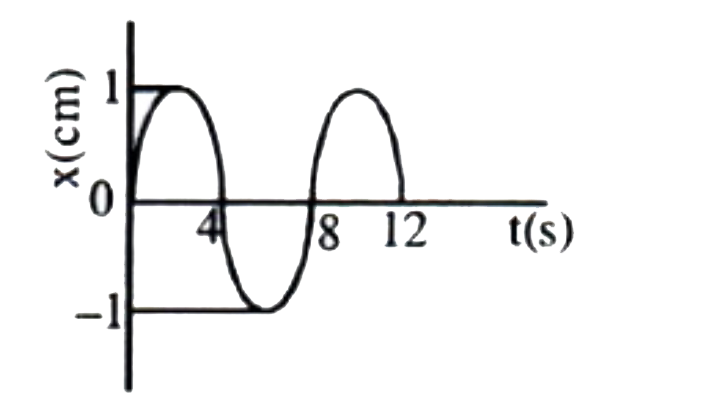The maximum speed and acceleration of a particle executing simple harmonic motion are 10 cm s^-1 and 50 cms^-2. Find the position of the particle when the speed is 8cms^-1.
The correct Answer is:A, B, C
To solve the problem step by step, we will follow the principles of simple harmonic motion (SHM) and the equations governing it.
Step 1: Identify the given values
- Maximum speed (vmax) = 10 cm/s
- Maximum acceleration (amax) = 50 cm/s²
- Speed at which we need to find the position (v) = 8 cm/s
Step 2: Write the equations for maximum speed and maximum acceleration
1. The maximum speed in SHM is given by:
vmax=ωA
where A is the amplitude and ω is the angular frequency.
2. The maximum acceleration in SHM is given by:
amax=ω2A
Step 3: Relate the two equations
From the two equations, we can express ω in terms of amax and vmax:
- From the first equation:
ω=vmaxA
- From the second equation:
ω2=amaxA
Step 4: Divide the two equations
Dividing the second equation by the first gives:
amaxvmax=ω2AωA
This simplifies to:
amaxvmax=ω
Step 5: Calculate ω
Substituting the known values:
ω=50cm/s210cm/s=5s−1
Step 6: Calculate the amplitude A
Now, substituting ω back into the equation for maximum speed:
10=5A⟹A=105=2cm
Step 7: Use the velocity equation to find position x
The velocity in SHM is given by:
v=ω√A2−x2
Substituting the known values:
8=5√22−x2
This simplifies to:
8=5√4−x2
Step 8: Solve for x
Dividing both sides by 5:
85=√4−x2
Squaring both sides gives:
(85)2=4−x2
Calculating (85)2:
6425=4−x2
Rearranging gives:
x2=4−6425
Converting 4 to a fraction:
4=10025⟹x2=10025−6425=3625
Taking the square root:
x=±65cm
Final Answer
The position of the particle when the speed is 8 cm/s is:
x=±1.2cm
- Maximum speed (vmax) = 10 cm/s
- Maximum acceleration (amax) = 50 cm/s²
- Speed at which we need to find the position (v) = 8 cm/s
1. The maximum speed in SHM is given by:
vmax=ωA
where A is the amplitude and ω is the angular frequency.
amax=ω2A
From the two equations, we can express ω in terms of amax and vmax:
- From the first equation:
ω=vmaxA
- From the second equation:
ω2=amaxA
Dividing the second equation by the first gives:
amaxvmax=ω2AωA
This simplifies to:
amaxvmax=ω
Substituting the known values:
ω=50cm/s210cm/s=5s−1
Now, substituting ω back into the equation for maximum speed:
10=5A⟹A=105=2cm
The velocity in SHM is given by:
v=ω√A2−x2
Substituting the known values:
8=5√22−x2
This simplifies to:
8=5√4−x2
Dividing both sides by 5:
85=√4−x2
Squaring both sides gives:
(85)2=4−x2
Calculating (85)2:
6425=4−x2
Rearranging gives:
x2=4−6425
Converting 4 to a fraction:
4=10025⟹x2=10025−6425=3625
Taking the square root:
x=±65cm
The position of the particle when the speed is 8 cm/s is:
x=±1.2cm
Topper's Solved these Questions
- BOOK - HC VERMA ENGLISHCHAPTER - SIMPLE HARMONIC MOTIONEXERCISE - Question for short Answer15videos
SIMPLE HARMONIC MOTION
- BOOK - HC VERMA ENGLISHCHAPTER - SIMPLE HARMONIC MOTIONEXERCISE - Objective-215videos
SIMPLE HARMONIC MOTION
- BOOK - HC VERMA ENGLISHCHAPTER - ROTATIONAL MECHANICSEXERCISE - Questions for short Answer21videos
ROTATIONAL MECHANICS
- BOOK - HC VERMA ENGLISHCHAPTER - SOME MECHANICAL PROPERTIES OF MATTEREXERCISE - Objective-27videos
SOME MECHANICAL PROPERTIES OF MATTER
Similar Questions
Knowledge Check
- Question 1 - Select One
The differential equation of a particle executing simple harmonic motion along y-axis is
Ad2ydt2+ω2y=0Bd2ydt2+ω2y2=0Cd2ydt2−ω2y=0Ddydt+ωy=0 - Question 2 - Select One
A particle executing simple harmonic motion with an amplitude 5 cm and a time period 0.2 s. the velocity and acceleration of the particle when the displacement is 5 cm is
A0.5πms−1,0ms−2B0.5ms−1,−5π2ms−2C0ms−1,−5π2ms−2D0.5πms−1,−0.5π2ms−2 - Question 3 - Select One
A particle is executing simple harmonic motion. Its total energy is proportional to its
Adisplacement from equilibrium positionBfrequency of oscillationCsquare of amplitude of motionDvelocity at equilibrium position
If the maximum speed and acceleration of a particle executing SHM is 20cm/sand100πcm/s2, find the time period od oscillation.
View SolutionFor a particle executing simple harmonic motion, the acceleration is proportional to
View SolutionThe position velocity and acceleration of a particle executing simple harmonic motion are found to have magnitudes 2cm, 1ms^-1 and 10ms^-2 at a certain instant. Find the amplitude and the time period of the motion.
View SolutionThe total energy of a particle having a displacement x, executing simple harmonic motion is
View SolutionThe x-t graph of a particle undergoing simple harmonic motion is shown below. The acceleration of the particle at t=23s is
 View Solution
View Solution

